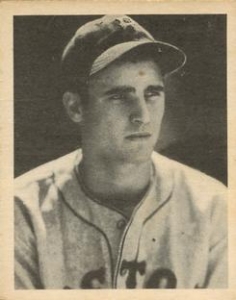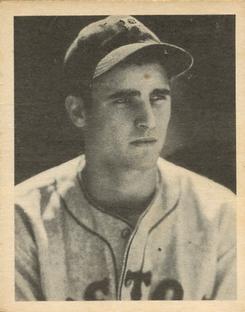June 8, 1950: Red Sox beat up on Browns with 29-4 shellacking
It was quite a homestand for the Boston Red Sox. From June 2 through June 11, 1950, they played 11 games and scored 127 runs, an average of more than 11½ runs per game.1 They had just come off the road, where they had dropped their last three games. The Cleveland Indians came to Boston and saw the Red Sox sluggers sweep a two-game set by scores of 11-5 and 11-9. Then the White Sox arrived and they were banged up for another pair of double-digit games, losing 17-7 and 12-0. Chicago stuck around for one more game, and Ken Holcombe won his first game of the season on his way to a 3-10 record; the White Sox won, 8-4.
off the road, where they had dropped their last three games. The Cleveland Indians came to Boston and saw the Red Sox sluggers sweep a two-game set by scores of 11-5 and 11-9. Then the White Sox arrived and they were banged up for another pair of double-digit games, losing 17-7 and 12-0. Chicago stuck around for one more game, and Ken Holcombe won his first game of the season on his way to a 3-10 record; the White Sox won, 8-4.
Then came the St. Louis Browns and they were crushed in their first game, 20-4, on June 7. Clyde Vollmer hit two homers in that game and so did Vern Stephens. Walt Dropo hit one. Vollmer and Stephens each drove in five runs; Dropo and Ted Williams each drove in three.
A 20-4 win on the hot Wednesday afternoon was pretty staggering; the temperature was 93 degrees. Maybe the Browns were still punch-drunk when Thursday rolled around.
The starting pitchers were Chuck Stobbs (3-1) for the Red Sox and manager Joe McCarthy, and Cliff Fannin (1-2) for Zack Taylor’s St. Louis Browns. The first inning was fairly uneventful — Stobbs retired the side in order, while Fannin gave up a single to Johnny Pesky and then walked Ted Williams, but neither scored.
Stobbs walked the first two batters he faced in the second, but a groundout and a double play saw another zero posted next to St. Louis on the Fenway Park scoreboard.
Al Zarilla doubled to right field to lead off the Boston second inning. Fannin walked Bobby Doerr. Then Matt Batts doubled off the wall, driving in Zarilla. A walk to Stobbs loaded the bases. Vollmer flied out to center field, and Doerr tagged up and scored to make it 2-0. Pesky flied out to right field and there were two down. Up strode Ted Williams. He’d homered off Fannin before; he did so again, slamming the ball 10-12 rows up in the right-field bleachers over the Red Sox bullpen.2 The bases now clear, Vern Stephens walked. Walt Dropo hit a two-run homer into the netting above the left-field wall. Then Zarilla hit his second double of the inning; Doerr singled in Zarilla. Batts flied out but it was 8-0, Red Sox.
Stobbs didn’t have an easy time of it in the top of the third; he struck out two but allowed three runs on two walks and three hits. 8-3, Red Sox. One of the strikeouts was of pitcher Ned Garver, who had pinch-hit for Fannin.
The Browns’ new pitcher was Cuddles Marshall. He walked five batters in the bottom of the third inning — including Stobbs, whom he walked twice. He gave up only three hits, but they included a two-run double by Vern Stephens and a two-run single by Dropo. Doerr’s sacrifice fly drove in the fifth run of the inning. 13-3, Red Sox.
In the fourth Stobbs set down the Browns 1-2-3. And the Red Sox then scored seven more runs. Pesky singled. Ted flied out. Stephens tripled in Pesky. Dropo singled in Stephens. After Zarilla flied out to short, Bobby Doerr homered. In came Sid Schacht to pitch for the Browns. Matt Batts reached on an error by the right fielder. Stobbs came up again and walked — for the fourth time in the game. Four innings, and the pitcher had already drawn four bases on balls. Vollmer doubled, driving in one run, and Pesky doubled, driving in two. Williams grounded out, short to first. (Ted made two of the three outs in the Red Sox half of the inning.)
Having not scored at all in the first inning, the Red Sox put across 20 runs in the second through the fourth. With the score 20-3 after four, the Red Sox public-address announcer invited the bleacherites to move out of the sun and enter the grandstand. There was plenty of room; attendance for the game was 5,105, reported as the smallest crowd of the season to date.3
St. Louis singled twice off Stobbs in the fifth, but neither runner scored. A walk and a double set up Bobby Doerr’s run-scoring fly in the fifth. He’d now driven in one or more runs in four consecutive innings. Matt Batts picked up an RBI, too. The sixth inning passed with no scoring by either team. In the top of the seventh, Stobbs walked two and then hit batter Hank Arft. But no one scored. Bobby Doerr hit a two-run homer in the bottom of the seventh. The score was 24-3.
Stobbs put down the side in the top of the eighth; Schacht batted for himself and made the third out. He was knocked out of the game in the bottom of the eighth. Rational rooters knew the Red Sox were unlikely to need to come up to bat in the bottom of the ninth. This was the team’s last chance to score more runs — so they scored five more. Pesky doubled and then Ted Williams hit his second homer of the game (over the left-field wall): 26-3. Vern Stephens singled and then Dropo hit his second homer of the game: 28-3. Zarilla flied out to “the foot of the center field wall,” which the Boston Herald said came “within inches” of going for a fifth double for himself.4
Bobby Doerr came up next and hit his third homer of the game; all three went over the left-field wall. 29-3. Doerr’s third homer was Boston’s seventh of the day and the 12th homer in the two games against the Browns.
Reliever Tom Ferrick got the final two outs.
The Browns scored another run in the top of the ninth, but fell 25 runs short of tying the game.
The final score was 29-4. The Red Sox had set a post-1900 record for runs scored (29) in a major-league game, and they did it all in eight innings. The record lasted 57 years until the Texas Rangers beat Baltimore 30-3 on August 22, 2007. Six of those Rangers runs scored in the top of the ninth.
The 17 extra-base hits in one game by the Red Sox remain as of 2019 a major-league record. There were other records broken at the time, enough that the Boston Traveler wrote, “Like the atomic bomb, the full results of the Red Sox demolition may not be known for several days. New records may be popping up the more the statisticians dig into the ruins and come up with new discoveries.”5
Everyone in the lineup had one or more runs batted in except Zarilla (though he was 5-for-7, with four doubles and a single, and scored four times) and Stobbs, who scored three times. Poor Clyde Vollmer collected eight at-bats in eight innings of play, but was 1-for-7, the only batter in the lineup who didn’t have two or more hits.
Doerr drove in eight runs, Dropo drove in seven, and Williams drove in five. Even with all the scoring — a combined 33 runs, 36 hits, and 18 walks, the game lasted only 2:42.
St. Louis right fielder Dick Kokos complained afterward, “The way they make outfielders chase the ball, you can’t catch your breath when it’s your turn to bat.”6
Maybe the Red Sox had run out of runs, after winning back-to-back games by a combined 49-8 No, they scored seven runs on Friday afternoon, but the Boston pitchers gave up 12. The Tigers arrived on Saturday, and beat Boston 18-8, and then the Red Sox lost both games of the Sunday doubleheader to Detroit, 6-2 and 9-6 (14 innings). It had been quite a homestand indeed.
Notes
1 Given the 154-game schedule that major-league teams played at the time, that was a pace that would have seen them score 1,777.99 runs for the season. As it was, they scored 1,027 — the largest total in Red Sox franchise history, even including the 162-game schedule that has been in place since 1961. Of the 29 games the Red Sox played during June 1950, there were 14 games in which one team or another scored 10 or more runs.
2 The Boston Herald said 10; the Boston Globe said a dozen.
3 F.C. Matzek, “Bosox Rewrite Record Book by Blasting Browns, 29-4,” Providence Journal, June 9, 1950: 12. On May 5, as it happens, the team had drawn only 3,415.
4 Arthur Sampson, “Red Sox Crack Records Galore, Crush Browns, 29-4,” Boston Herald, June 9, 1950: 34.
5 John Drohan, “Thunder of Red Sox Bats Echoes in Hurlers’ Ears,” Boston Traveler, June 9, 1950: 34.
6 Hy Hurwitz, “Sox Break 5 Major Records in 29-4 Rout of Browns,” Boston Globe, June 9, 1950: 36. As compiled by Hurwitz, the five records were:
- Runs scored in a game (29), eclipsing the 28 scored in a game by the 1929 St. Louis Cardinals;
- Runs batted in, in a game (29); the previous record was 28 by the 1929 St. Louis Cardinals;
- Total bases in a game (60), five more than the 1893 Cincinnati Reds had had;
- Most runs scored in two consecutive games (49); the 1925 Pittsburgh Pirates had 45;
- Most hits in two consecutive games (51); the 1922 Pirates had once hit 49.
Additional Stats
Boston Red Sox 29
St. Louis Browns 4
Fenway Park
Boston, MA
Box Score + PBP:
Corrections? Additions?
If you can help us improve this game story, contact us.


